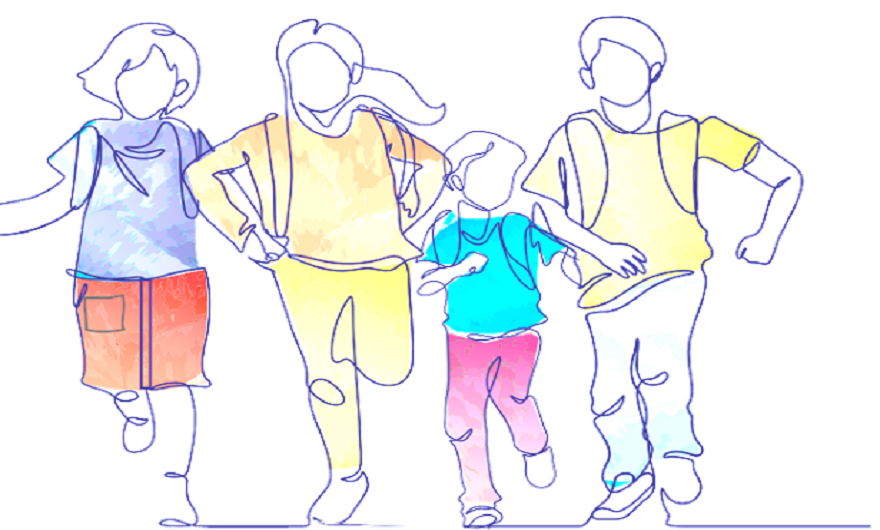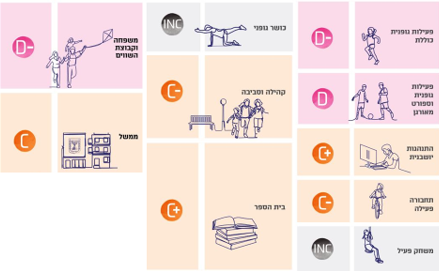
The State of Israel joined the Active Healthy Kids Global Alliance (AHKGA), as part of the efforts to promote physical activity among children and adolescents in the national level and prepare a report on the state of activity among children and adolescents in Israel, for the purpose of establishing indicators and a foundation for new policy recommendations for the promotion of physical activity in Israel.
The participation in the international methodology includes mapping information sources and examining databases, collecting and analyzing data and preparing a report card on the physical activity in the population. The data sheet enables national assessment of the state of physical activity among children and adolescents according to ten international indices related to physical activity.
The preparation of the Israel Report Card included mapping information sources and databases, collecting and analyzing the data, determining the scores and formulating recommendations for professionals and policy makers. The process was conducted in collaboration with a diverse expert forum that was established especially for this purpose and included representatives of the government, medical establishments, the academy and the third sector (see a list of forum members on the back of the report). The forum determined that the report card will refer to children from preschool to 18 years of age and dedicate a chapter to children with special needs.
What is the Active Healthy Kids Global Alliance?
57 countries are partners in building a comparative, multinational information base on the subject of physical activity among children and adolescents (Global Matrix 4.0). The goal of the organization is to help countries promote policies and programs that improve physical activity indicators for the health and well-being of children and adolescents.
What score did Israel get?
Israeli children were found to be particularly sedentary and therefore got the score D (on a scale between A – F) according to the overall physical activity index. The majority of children and adolescents in Israel do not exercise in accordance with international recommendations, which state that school children must be active for at least 60 minutes a day, with an emphasis on intensive aerobic activity. Approximately 32% reported they performed moderate to intensive activity for at least 60 minutes 4 days a week or more and only 9% reported daily activity. The COVID-19 crisis worsened things and only about 3% reported daily physical activity of 60 minutes.
The Report Card for Children and Adolescents in Israel

The report card, which should to be a database and the foundation of policies, educational programs and partnerships, reveals that despite the actions and resources dedicated to the promotion of physical activity among children and adolescents, the efforts are not sufficiently focused and consistent and therefore a significant leap forward is required.
D minus was the score in the field of physical activity in family settings. Only about a quarter of parents in Israel exercise sufficiently according to the international recommednations for adults (at least 150-300 minutes of moderate physical activity a week, or at least 75-150 minutes of vigorous physical activity) and only about a quarter of the children and adolescents reported that they do physical activity with their parents or go on trips with their parents every day or most days of the week.
And what, after all, is Israel managing to do to promote physical activity?
It is evident that Israel is more successful in creating opportunities for physical activity in educational settings and therefore got the score C plus. Most schools in Israel offer their students two hours of physical education per week in grades 1-12, taught by professional teachers, and daily access to facilities and equipment. However, only 50% of the educational institutions have sport facilities. Only about 30% of the educational institutions are recognized as health-promoting schools that emphasize a healthy lifestyle and physical activity, at home, at school and in the community.
How can we improve?
Significant health promotion efforts are required to deal with the decrease in physical activity, which resutls, among other things, from the modern lifestyle, increased screen time, sedentary behavior and the availability of harmful foods. These are particularly important factors among populations that are inactive or without any access to existing programs. The Israeli expert forum was established especially for this purpose and included representatives of the government, medical establishments, the academy and the third sector. They created a wide and comprehensive set of action strategies and recommendations that need to be implemented. Here are some of these recommendations (the full recommendations appear in the 2022 Israel Report Card for Children and Adolescents):
- Policy: setting national goals for the promotion of physical activity among children and adolescents, monitoring, assessment.
- Health system: implementing pediatricians' and family physicians' recommendations to participate in physical activity, encouraging inactive children, promoting family physical activity.
- In educational settings: integrating intervention programs to promote active play in kindergarteners, adding physical activity modules (as part of classes other than physical education classes) in schools.
- In the urban environment: building sport facilities in new schools and completing them in existing ones, increasing the accessibility of swimming pools. Creating infrastructure for walking and active transportation in local authorities.
- Raising awareness: sharing knowledge, campaigns, give targeted recommendations to parents through student health systems.
What is an active and health day in a child's life?
Raise the heart rate
For ages 5-18, at least 60 minutes of moderate-intensive physical activity a day.
In the early childhood, at least 180 of active play and age–appropriate physical activity.
Sleep
Regular sleeping hours:
9-11 hours of sleep a night for ages 5-13.
8-10 hours of sleep a night for ages 14-17.
Move
Physical activity and movement throughout the day: walking to school, incorporating movement into learning, walking the dog.
Sit down less
Reducing the sedentary time, no more than two hours a day watching screens.
Eat healthy
Drinking water and eating healthy meals throughout the day according to the food rainbow.
Recommendations by age
The international recommendations for age-appropriate daily physical activity:
Early childhood
It is recommended to perform at least 180 minutes of active play and age-appropriate physical activity a day.

Elementary school children (ages 6-12)
It is recommended to perform at least 60 minutes of moderate-intensive aerobic physical activity a day. As part of the exercise, incorporate physical activity that strengthens the muscles and skeleton at least 3 times a week.

Adolescents (ages 13-18)
It is recommended to perform at least 60 minutes of moderate-intensive aerobic physical activity a day. As part of the exercise, incorporate physical activity that strengthens the muscles and skeleton at least 3 times a week.

Intensive physical activity is such that raises the heart rate and causes heavy breathing in a way that makes it difficult to complete a sentence without needing to stop and breathe.
In the whole world, as well as in Israel, dramatic measures are needed to improve the level of physical activity among children and adolescents. Professor Mark Tremblay, president of the AHKGA organization states that "without a significant effort to readjust the modern lifestyle of children and adolescents, the health and future well-being of our children will be at great risk."
The report card booklet includes international guidelines for active and healthy children. This is a summary of recommendations given by world-leading health organizations in the world and prominent Israeli child health and public health associations.
The downloadable report card is a tool for policy makers and professionals.
Further reading
The official website of Active Healthy Kids
Global Matrix 4.0 Physical Activity Report Card Grades for Children and Adolescents: Results and Analyses From 57 Countries
Israel Physical Activity Report Card for Children and Adolescents 2022



